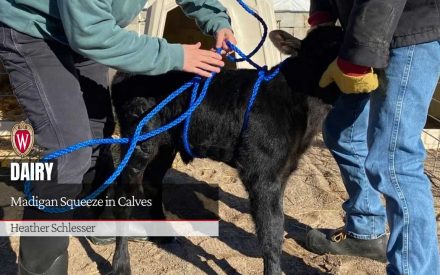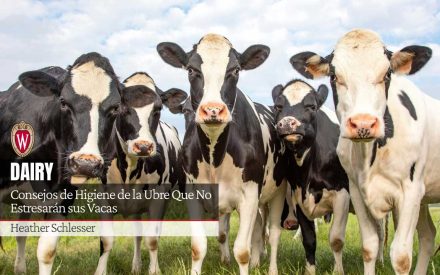Body condition and locomotion
Body condition is an important consideration when deciding when a dairy animal retires into her “second career”. Thin cows with poor condition are often discounted at sale barns, so evaluating which cows may be candidates for improving condition is an important consideration prior to shipping a cull cow to get the most value. It is also important to note that adding condition may be necessary for animal well-being prior to transport.
Body condition score (BCS) is evaluated on a one to five scale on dairy animals. Key places to evaluate for condition, or fat cover, include the following areas: topline, rear view of the hooks, side view of the area between the hooks and pins, and the cavity around the tailhead (Edmonson et al., 1989). Additional information on the BCS process can be found at https://bit.ly/dairyBCS.

Key places to evaluate for fat cover include the following areas: topline (1), rear view of the hooks (2), side view of the area between the hooks and pins (3), and the cavity around the tailhead (4). Cattle photos courtesy of Matt Lippert and graphic layout by Lyssa Seefeldt.
Do not transport cows with a poor BCS or with mobility issues. On a one to five scale, generally those with a BCS of less than two should not be transported. A study showed that locomotion scores improved in dairy cows fed a high energy diet for an extended period of time. The study gives credit to removing the animal from stresses incurred from lactation and milking for the reason these scores increased (Allen et al., 2009).
Who should be selected for feeding out
Selectively feeding cows that are thin (BCS less than three), but still healthy and mobile, should have a greater ability to increase value compared to cows already well conditioned. These cows could be kept on-farm and put on a feedlot type diet consisting mainly of corn silage, corn, protein supplements (byproduct feeds and urea), possibly some haylage, vitamins and minerals. Two studies have shown improvements in carcass quality of animals fed a high energy diet for an extended period of time compared to cows that had been harvested directly from a dairy (Stelzleni et al., 2007; Allen et al., 2009). You should expect that to change BCS by one point for, there needs to be a weight gain of 150-200 pounds for Holstein breed cattle, with less gain needed in smaller breeds. Evaluating BCS will help estimate how much weight gain is needed, which will allow you to estimate how much feed-out time is required.
Feeding considerations
Farmers need to consider the risks and potential net returns of retaining market cows longer. Owning the cows longer will have feed, labor, housing, and bedding expenses. It is important to evaluate the net returns for different options being considered while keeping in mind market volatility. Important considerations include:
- Do you have sufficient feed and space to keep the animals additional time?
- The right decision for your farm may change over time as pasture and new forages become available.
Most milk cows are being fed a high energy diet and can continue with a similar high energy diet without the costly supplements/additives. Targeting 12-13% crude protein and energy of 0.7-0.75 Mcal NEl/lb will help these cows add weight quickly. A general thumb rule for the amount of feed required to add weight to thin cattle (feed to gain conversion rate) is approximately 10-12 pounds of feed on a dry matter basis needed for 1 pound of weight gain. Research has shown a rate of gain around 3 pounds per day and can be used for estimating costs when feeding a finishing type ration. A nutritionist is needed to help develop a ration that meets growth targets.
Before deciding to retain cull cows, ensure you have adequate housing space and bedding. Keeping cows dry and clean is critical to achieve high rates of gain with muddy outlots not a good housing strategy.
The Wisconsin Beef Information Center has a Feedlot Enterprise Budget Spreadsheet that can help look at the costs associated with finishing a cull dairy cow. This spreadsheet can be found at: https://livestock.extension.wisc.edu/article-topic/decision-tools-and-software/.
Economics of getting a cow to her second career
We can estimate the economics of getting a cow up one body condition score and ready for transport if we make some assumptions. If you target three pounds of gain per day, and you need 150-200 pounds of gain to achieve an increase of one BCS, you will need about two months to do so for each full point increase of BCS.
To calculate a cost to this gain, we are using an example ration composed of 67% corn silage, 20% corn grain, 10% moderate quality haylage, 1% urea, and 2% as vitamins and minerals on a dry matter basis. We are estimating an intake of 30 pounds of dry matter per day (similar to a dry cow), and not accounting for other costs such as labor, housing, bedding, etc. The estimated feed costs per day is $2.00. This estimate utilized the following ingredient cost estimates on a dry matter basis: $100/ton corn silage; $3.25/bushel corn grain; $150/ton haylage; $500/ton urea, and $1,000/ton minerals/vitamins. This is a relatively conservative ration in terms of the amount of grain utilized and assumes adequate available forage. Additional gain potential as the amount of corn is increased in the diet could be realized if forage is unavailable in necessary quantities. If utilizing higher grain diets, note that an adjustment period of two to three weeks will be necessary to allow adaptation to the diet.
In current markets, a thin BCS 2.5 cow at 1,500 pounds will return approximately $600 at $0.40 per pound while not incurring any additional yardage or feed costs. Feed costs plus yardage is estimated at $2.75 per day per animal for 60 days of feeding would cost $165. Assuming you decide to retain ownership of this thin animal, feed-out for two months, and achieve 3 pounds of gain per day, she would gain 180 pounds. The greater conditioned animal could achieve $0.45 per pound ($756 return) or $0.50 per pound ($840 return). In this scenario when you subtract out the additional costs you would have a loss of $9/head or gain of $75/head respectively, so it is important to consider your actual costs, estimated growth, and the potential selling price. Well managed animals will have good potential for additional returns, but there is always some financial risk to adding condition to cull cows.
References
Allen et al., 2009. Effect of pre-slaughter feeding and ractopamine hydrochloride supplementation on growth performance, carcass characteristics, and end product quality in market dairy cows. J. Anim. Sci. 87: 2400-2408.
Edmonson, A.J. et al. 1989. A body condition scoring chart for Holstein dairy cows. J. of Dairy Sci. 72: 68-78.
Stelzleni et al. 2007. Benchmarking carcass characteristics and muscles from commercially identified beef and dairy cull cow carcasses for Warner-Bratzler shear force and sensory attributes. J. Anim. Sci. 85: 2631-2638.
Download Article

 ▶️ Watch: Confort y diseño de instalaciones en granjas lecheras
▶️ Watch: Confort y diseño de instalaciones en granjas lecheras Madigan Squeeze in Calves
Madigan Squeeze in Calves Consejos de Higiene de la Ubre Que No Estresarán sus Vacas
Consejos de Higiene de la Ubre Que No Estresarán sus Vacas ▶️ Watch: Generalidades de la podología bovina especializada
▶️ Watch: Generalidades de la podología bovina especializada


